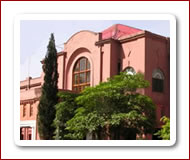Dr. Syed Aamer Mehmood
Title:
Seasonal variations in libido, semen quality, freezibility and fertility of cholistani bulls
Abstract:
Following the global lead in conservation/propagation of indigenous livestock, an effort has been made through the present study to highlight a formerly neglected indigenous cattle breed of Pakistan- Cholistani- being reared by the nomadic herders of the Cholistan desert, Pakistan. The study was executed with a specific objective to assess baseline data, seasonal variations and correlations between libido, semen quality, freezability and fertility of Cholistani AI bulls (n=06). Four seasons of 2 months duration each were defined as i) stress free autumn (October-November), ii) stressful winter (December-January), stressful dry summer (May-June) and iv) stressful wet summer (July-August).
The overall mean (± SEM) values for Rx Time, libido index and TLTE in the present study were 4.5±1.10 min, 3.48±0.03 and 4.61±0.30 min, respectively. Non-significant (P>0.05) differences were found in all the parameters during four seasons.
The overall mean value for ejaculatory volume, number of ejaculates per bull, pH, mass motility, individual sperm motility, number of dozes frozen per bull and sperm concentration in the present study were 4.90±0.14 mL, 1.89±0.02, 6.73±0.02, 2.25±0.06, 61.26±1.02%, 208.26±8.42 and 989.73±27.4 million/mL, respectively. In general, all the seminal attributes revealed significantly (P<0.05) better results in stressful seasons as compared to stress free season, with the exception of number of ejaculates per bull and pH which was not affected significantly by seasons.
In terms of semen production, 39778 doses of 0.5 mL straws were frozen during the study period. Significantly higher number of doses per bull (P<0.05) was frozen during dry (245.37±17.84) and wet summer (250.37±17.75) as compared to autumn (191.4±14.22) and winter (143.92±11.25); the difference between the latter two seasons was also significant, while it was non-significant between the former two seasons.
The subjective analysis of spermatozoa revealed that percentages of live, morphologically normal sperm and those with intact acrosome were 86.24±0.49, 85.94±0.45 and 86.82±0.37, respectively. Higher (P<0.05) mean values were recorded for all three parameters during stressful winter and dry summer as compared to wet summer and autumn; the difference between the former two seasons was, however, non-significant.
The overall mean values for post thaw sperm motility, viability, normal morphology, acrosome integrity, plasma membrane integrity and DNA integrity were 58.60±0.60, 78.24±0.60, 78.31±0.46, 80.79±0.39, 75.61±0.41 and 98.46±1.02%, respectively. The percentages of motile and live sperm was lower (P<0.05) in stress free autumn, being higher in the remaining three seasons. Higher percentages of morphologically normal sperm were noticed in stressful winter (80.8±0.7) and dry summer (80.4±0.5); whereas, higher DNA integral sperm were noticed in dry summer (98.6±1.1%) and wet summer (98.7±1.1%), remaining lower in other two seasons.
In terms of fertility, the overall percentage for fertility in the present study was 71.18±1.21. Significantly (P<0.05) lower fertility rate (67.26±1.30%) was seen in wet summer i.e. July and August. However, it was almost the same in the remaining three seasons.
Results on correlations between libido index and fresh semen indices revealed that libido index had a negative correlation with ejaculatory volume (r = -0.420; P<0.01) and pH (r = -0.171; P<0.05). However it was non-significantly correlated with mass motility, individual sperm motility, sperm concentration, sperm viability and sperm morphology. The result on correlations between various fresh seminal attributes, significantly positive correlations between individual sperm motility and mass motility, normal morphology and viability, and acrosome integrity and viability were noticed in the present study. Regarding the results on correlation between various post thaw seminal attributes, all the parameters were found to be positively correlated.
In a nutshell, semen quality, freezability and fertility of Cholistani bull semen are better in stressful seasons as compared to stress free season. The acceptable quality of semen of Cholistani bulls recorded during wet/dry summer in the present study is an indicative of the fact that this breed has an innate ability of being well adapted to the harsh, hot desert climate. Furthermore, the present study revealed that the Cholistani breeding bulls have an amazing fertility index throughout the year as indicated by a higher fertility rate in the present study.
|



